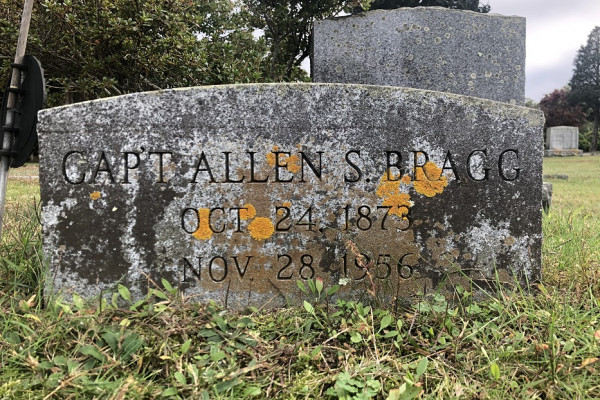
Allen S. Bragg lies in a Brewster cemetery, Don Wilding photo.
By Seth Rolbein
At the most terrifying moment, storm overwhelming a ship, wind howling, waves off the bars pounding the hull, deck awash, many a fisherman and mariner has faced horrifying options:
Abandon ship and take your chances trying to get through the surf.
Go below for protection, hoping the cabin is not your coffin.
Lash yourself to the mast to avoid getting washed overboard, praying the ship stays upright.
Go one step further and climb into the rigging, get some space between you and the sea, hoping either you don’t plunge, bound, into the rage, or die up there like a frozen fly in a web.
Each strategy has worked many times, each has failed many times.
Here’s the story of one time when lashing worked.
Don Wilding, whose book “Shipwrecks of Cape Cod” is a great history and compendium of tragedy and heroism, sums it up well when he says, “There can’t be more of a Cape Cod washashore than Allen S. Bragg.”
Bragg, born in 1873, grew up on North Carolina’s Outer Banks south of Cape Hatteras on the island of Ocracoke, a captain by the time he was in his 20s (the famous Fort Bragg named for a relative).
On Thanksgiving weekend, 1898, he was plying south from Maine toward New York at the helm of the Mary A. Tyler, with a cargo of paper from the northern mills. History buffs will know this was the moment of the Portland Gale, named for the most famous ship lost that weekend, the most destructive storm in New England history.
Bragg said years later that he saw the Portland herself, passing so close in the raging gale that he could touch it. Bragg was fighting for his own life, with about seven men onboard. Rather than wrecking on the outer shore of the arm of Cape Cod, as so many did, he managed to push farther southwest, inside the hook of Provincetown into Cape Cod Bay. He was driven into the shallows and crashing waves at Paine’s Creek in Brewster, the force so strong it broke his ship in two.
Bragg’s choice for himself and his crew was to lash to the mast and rigging. Throughout that night, frozen, vomiting from seasickness, they were plunged over and over into the sea “like splinters,” Bragg’s daughter Miriam recalled her father saying years later. But they kept coming up.
Come morning, wind subsiding, tide receding, the boat was spied from shore. Captain Jeremiah Wixon from a well-known Cape Cod family, who lived on Stony Brook Road in Brewster, pulled together a rescue team. Struggling through the foaming surf they got buoys to what remained of the deck, and rescued all hands.
Wixon took Bragg home to recover, while many in Brewster worked the shore in traditional scavenging fashion to recover and dry out rolls of paper washing in. “For many many years, that paper was used to produce the school newspaper in Brewster,” Wilding reports.
Bragg not only recovered, he decided he stayed put. Six years after the wreck he married his rescuer’s daughter, Margaret. They had several daughters and a son, calling Brewster home for the rest of their lives.
Bragg didn’t just sit around, reports Wilding; in World War I he was a Naval lieutenant commander leading transports, and in World War II as a civilian he took charge of a Michigan shipyard. Back home he became a cranberry grower, a Mason, and a pillar in the Harwich Baptist Church. He lived into his 80s, dying in 1956, buried in Brewster’s cemetery on Lower Road.
The day of his death was the very day he bound himself to the mast and saved his life 56 years earlier — November 28.
(Don Wilding’s “Shipwrecks of Cape Cod,” published by The History Press, is available at local bookstores. Don’s website is dwCapeCod.com. He expects his next book to be all about the one amazing storm in 1898 that Bragg survived, though many didn’t.)
